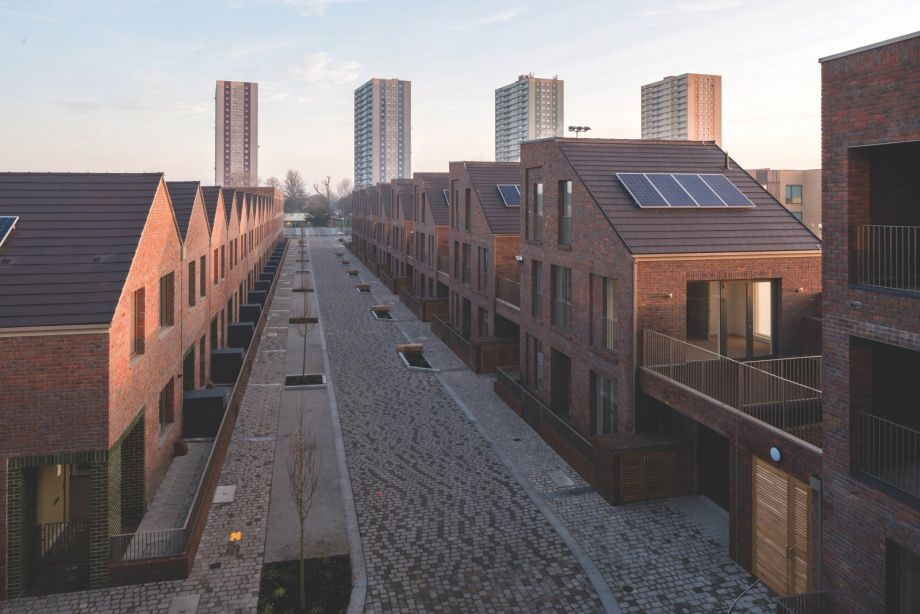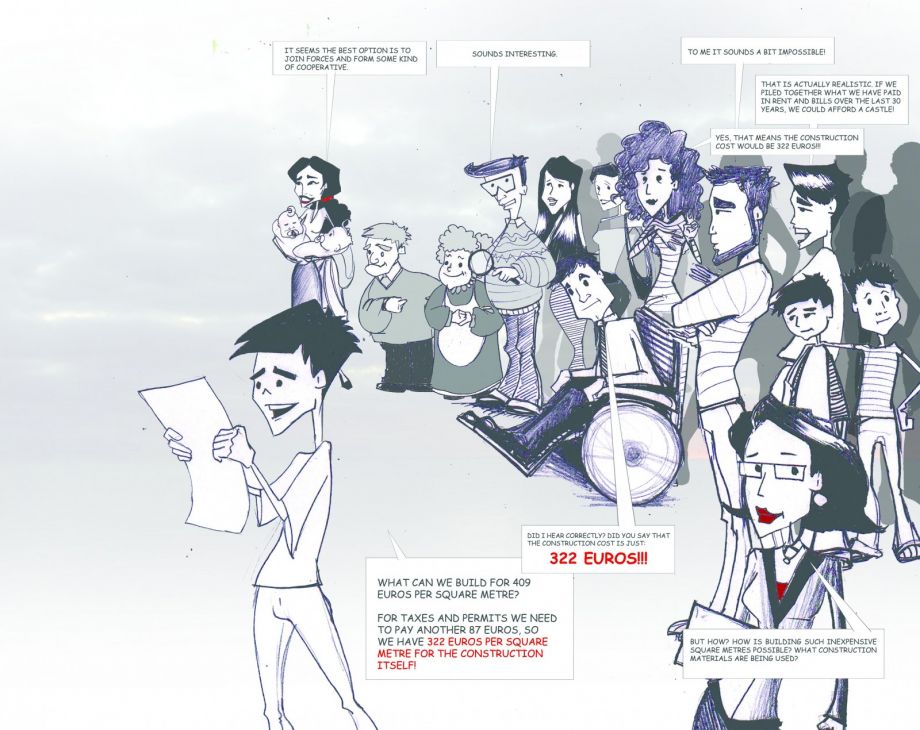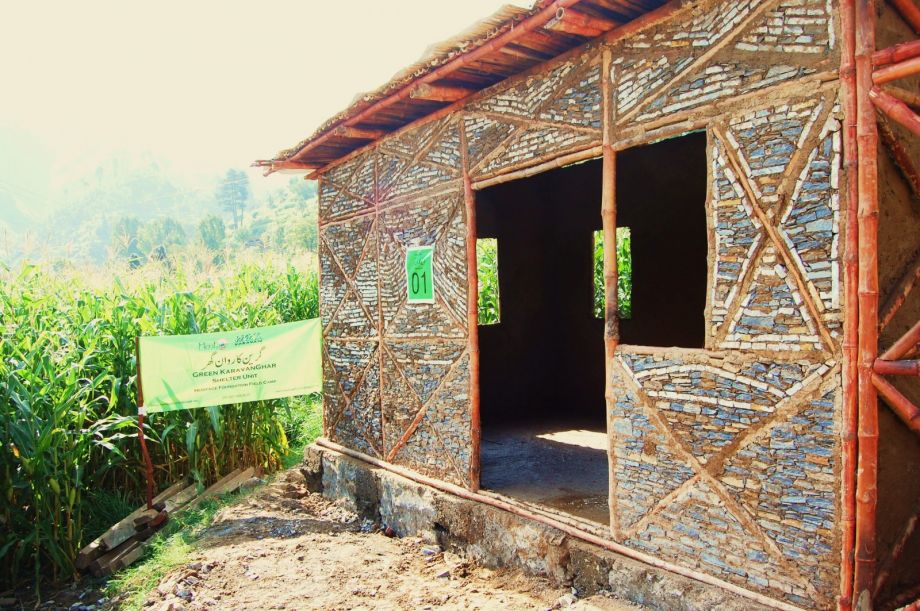Are You A Vanguard? Applications Now Open
CODEPINK Women for Peace mobilizes to protest the bailing out of banks instead of homeowners.
CODEPINK Women for Peace
This is your first of three free stories this month. Become a free or sustaining member to read unlimited articles, webinars and ebooks.
Become A MemberEDITOR’S NOTE: The following is the introduction to “Housing as Intervention: Architecture towards Social Equity,” a 17-essay volume of Architectural Design (AD), guest edited by Next City Vanguard Karen Kubey, that examines how housing projects around the world, and the design processes behind them, might be interventions toward greater social equity. Next City is pleased to welcome Karen as our first guest in a new online seminar series, Thursday, November 1, 2018, at 1:00. Register here to attend the pay-what-you-wish event; if you become a sustaining Next City member, you will receive “Housing as Intervention” as a thank-you gift.
In the face of persistent social inequities worldwide, how can architects make a meaningful contribution? Housing’s primary position in our lives, economies and the built environment makes it a natural site of intervention in the complex fight against systemic injustices. “Housing First” policies acknowledge that the pursuit of a healthy, fulfilling life is possible only when we have a stable home; while a growing body of research demonstrates that people with affordable, well-designed housing lead healthier, happier lives than those who are rent-burdened or ill-housed. Beyond policies and data showing the generative value of housing, people across the world seek a sense of dignity and identity through their homes.
Housing projects, and the design processes behind them, can be interventions towards greater social equity, defined here broadly as fair access to opportunities and resources for an economically stable, healthy life. Despite its potential for impact in residents’ lives — and though it was Modernism’s central project — “housing” is often considered separate from “architecture.” As architect Susanne Schindler puts it, housing is thought of as a “socioeconomic product to be delivered at the least possible cost,” while architecture is considered a “cultural endeavor.” Amid regulatory constraints, bank and developer profits, community NIMBYism, and supply-chain challenges, the architecture of housing can seem less relevant than the economic or social drivers of its production. Existing housing systems leave resident needs unmet, with too few affordable options supporting current and emerging demographic shifts and types of households. The privatization and commodification of housing have helped to drive massive gaps in income and health outcomes, providing fertile ground for alternative approaches to its design and delivery. These ground-floor apartments at Dujardin Mews, Enfield, London, have internal courtyards that provide extra outdoor amenity space and allow natural light and ventilation deep within the plan. Design by Karakusevic Carson Architects with Maccreanor Lavington. (Photo by Mark Haddon)
These factors have also largely eroded the role of the architect. While architects of the postwar period such as the late Neave Brown, working with the London Borough of Camden, led the creation of new forms of housing serving a wide range of city dwellers, designers today have paid the price for the perceived failures of social housing and Modernism. Procurement systems that favor real-estate profits above all else, combined with design and construction processes that involve architects only in discrete ways, have further foreclosed architects’ engagement with the full design and delivery process, especially in terms of collaborative interactions with potential occupants, limiting their capacity to intervene positively in residents’ lives.
In exceptional cases, however, architects around the world are bringing their unique expertise to bear on complex housing challenges, addressing them collaboratively and head on. These designers are helping to reform building regulations, offering new financing models, promoting creative solutions to community needs, and developing new typologies and materials strategies, all while creating beautiful buildings. Their housing projects do not follow the typical model that serves capital and often involves no architects at all. Helping us to envision a future with fair access to opportunities and resources, this collaborative work — in partnership with residents and allied professions — offers a way forward for more equitable housing and more meaningful roles for architects.
Neither urbanization nor the “housing crisis” are new phenomena. As German philosopher Friedrich Engels wrote in “The Housing Question of 1872:”
“The so-called housing shortage … is not something peculiar to the present; it is not even one of the sufferings peculiar to the modern proletariat in contradistinction to all earlier oppressed classes. On the contrary, all oppressed classes in all periods suffered more or less uniformly from it.”
Nineteenth-century housing reforms in industrialized cities like London and New York — in the form of model housing designs and building codes that increased access to light and air — were fueled by fears of the spread of infectious diseases like tuberculosis from the crowded tenements into wealthier neighborhoods.
Today we are experiencing unprecedented increases in urban populations, along with income inequality so extreme that the 42 richest people in the world control as much wealth as the 3.7 billion who make up the poorest 50 percent. Globalized investment in luxury housing, combined with the withdrawal of public funding from social housing provision in Western countries and forced migration due to conflict and disaster worldwide, has led to precarious housing conditions for wide swaths of society. Severe income inequality is again making housing insecurity impossible for even the upper classes to ignore. In late 2017, a fire that started in a homeless encampment destroyed 160 hectares (400 acres), including six homes in Bel-Air, one of Los Angeles’s richest neighborhoods, while nearby San Diego experienced a hepatitis outbreak emanating from unhealthy conditions in growing homeless camps.

STEALTH.unlimited won the MILD Home competition for ecologically sustainable housing with this proposal for a non-profit, cooperatively owned and developed settlement of 188 units, designed to be socially and economically sustainable as well. Nova Moba’s financing model, combined with its energy-efficient materials and systems, would reduce housing and utilities costs to 15 percent or less of household income. (Image credit: project “Nova Moba Za Ovo Doba” by Smarter Building team, Who Builds the City)
Beyond these extreme examples, housing has become unaffordable for middle-class residents of cities all over the world. In London the average tenant pays 49 percent of his or her pre-tax income towards rent, while neighborhoods in Sydney lost 10 to 20 percent of their teachers, firefighters and other ‘key workers’ from 2006 to 2016 as housing prices soared and those residents moved to further-flung locales. History tells us that improvements in housing for people with lower incomes often come not from benevolence towards vulnerable populations, but out of the self-preservation of the more powerful, against the spread of disease or to prevent uprisings. Today’s predicament has grown severe enough to reach those with the political capital to improve housing for the poor and middle classes, a critical shift towards the larger redistribution of resources needed to meaningfully reduce inequality, potentially bolstering efforts by and for those who are ill-housed.
Though many of the global, systemic factors that have led to our current state are well beyond the scope of architecture, the profession is implicated in inequitable forms of urban planning, including spatial segregation, that architects today must work to undo. More than access to healthcare, or even our genetics, the best predictor of our health is where we live, making housing improvements especially urgent. Introducing this issue and providing a historical and economic context, Matthew Gordon Lasner argues that architects have played central roles in housing betterment since the 19th century, while Robert Fishman charts how decades of neoliberal housing policies in developed countries have contributed to today’s instability.
The re-emergence of architects’ engagement with social justice in the form of the public interest design movement, born during the recession of the early 2000s and championed by organizations including Architecture for Humanity and Public Architecture, has now been embraced by mainstream institutions. The 2014 Pritzker Prize was awarded to Shigeru Ban, an architect known for his humanitarian structures, and the 2016 Venice Architecture Biennale, curated by architect Alejandro Aravena, winner of that year’s Pritzker, confronted social and environmental issues. Building on Modernist housing tenets, civil rights-era work led by community design centers, and more recent public interest or “social impact” design, the work highlighted in this issue strives to contribute to the public good. These are not small, pro-bono design-build structures, like many early public interest design projects, but rather substantial built and speculative work primarily integrated into professional, profitable architecture practices.
This issue focuses on housing for people who are not served by the prevalent modes of shelter provided by the private market. Since terms for the range of publicly and privately funded types of housing covered differ regionally — for instance “affordable housing” is typically defined in the U.S. as costing no more than 30 percent of a household’s income, and in the U.K. as 80 percent of market rate — terminology is defined within the articles themselves. Beyond these definitions, the question for communities facing displacement amid skyrocketing market-rate rents is “affordable for whom?” Housing units designated as affordable by governments, the product of negotiations between developers and local authorities, often remain out of reach for low-income residents.
Supported by evolving research, policies, funding and collaborations, the architects featured in this AD are working cleverly within existing housing systems while advocating to change them. Some designers are attempting to increase affordability by cutting housing development costs, often finding that the most promising strategy is not to produce cheaper housing structures, but rather to reduce or eliminate the cost of land. Marc Norman explores speculative projects adopting this approach to “designing affordability,” which create new units within existing buildings or on parking lots, and proposes policies that allow this type of development. Through a decade-long obsession with accessory dwelling units, Dana Cuff, director of the University of California, Los Angeles’s cityLAB, has developed design prototypes and urban analyses, and co-authored successful legislation that recently eased the way for backyard homes throughout the state.

Working closely with people displaced by disaster and creating designs simple enough to be built by them, Yasmeen Lari, Pakistan’s first female architect, has led or influenced the building of 45,000 disaster-relief structures. Each of the 270 Green KaravanGhars flood-resistant, low-cost homes made of environmentally sustainable local materials was constructed by community members, artisans and volunteers in just eight days. (Credit: Heritage Foundation of Pakistan)
Beyond cost-saving strategies, architects are taking on expanded roles in housing design and development processes as a means to produce more equitable project outcomes, or projects that contribute to the health and wellbeing of residents and neighbors in need. In London, Karakusevic Carson Architects has led robust resident engagement processes for its regeneration projects, ultimately creating beautifully designed social housing built with the needs of current residents in mind. Stateside, Philadelphia’s Interface Studio Architects (ISA), led by Brian Phillips and Deb Katz, has partnered with health researchers to develop housing designs that might better support desired health outcomes for residents, such as reduced rates of chronic disease and improved mental health. Emily Schmidt and Rosalie Genevro present the work of Architects for Social Housing (ASH), Frédéric Druot Architecture and Lacaton & Vassal, and ERA Architects/Tower Renewal Partnership, all of whom, instead of following a private developer’s brief, have invented solutions to housing challenges that they have self-identified. Working in Rwanda, Fatou Dieye charts the emergence of a new kind of “architect/environmental-urbanist-planner-value-chain expert,” providing a vital response to growing housing demands.
The search for affordable housing cannot be separated from new ways of living and the growing environmental and political challenges affecting where and how we live. Only a small percentage of households comprise the nuclear families for which much of global urban housing stock was built, while conflicts and natural disasters are reshaping the housing landscape. Neeraj Bhatia and Antje Steinmuller examine new cooperative domestic typologies, where sharing common spaces such as dining areas gives residents access to “a form of luxury” they can afford. Na Fu profiles Urbanus’s work in rapidly urbanizing China, which supports rural forms of community through a hybrid housing typology and urban village infrastructure. As more and more people are displaced by natural disasters and conflicts, Cynthia Barton, Deborah Gans and Rosamund Palmer ask how post-disaster housing might contribute to long-term equity, while Kaja Kühl and Julie Behrens present work on housing for refugees that promises to improve neighborhoods for newcomers and long-time residents alike. Meir Lobaton Corona examines celebrated low-cost housing prototypes from Mexico alongside specific housing needs in diverse locales. Pollyanna Rhee looks at how architects’ experiments with timber construction may go beyond environmental sustainability to support social and economic outcomes. And San Francisco Bay Area housing leaders Carol Galante, Michael Pyatok and Joshua Simon give us a glimpse into their advocacy for more equitable housing systems, and offer opportunities for architects to make greater impacts in residents’ lives.
As sociologist David Madden and urban planner Peter Marcuse assert: “The built form of housing has always been seen as a tangible, visual reflection of the organization of society. It reveals the existing class structure and power relationships.” The pursuit of a more equitable society and the creation of new forms of housing have long gone hand in hand. It has never been more urgent for architects to work towards reducing economic, health and social inequities. While the long-term impacts of the projects in this issue will only reveal themselves with time and inquiry, they help us to reimagine architects as collaborative leaders, helping to improve residents’ lives. More equitable housing solutions and design processes prove as diverse as the challenges they address. As the role of architects evolves, engaging in these interlinked issues has the potential to shift design practice at large, allowing designers to contribute to the common good.
From “Housing as Intervention: Architecture towards Social Equity,” a 17-essay volume of Architectural Design (AD), guest edited by Karen Kubey. Copyright © 2018 John Wiley & Sons Ltd. Reproduced by permission of John Wiley & Sons Ltd.

Karen Kubey is an urbanist and architectural educator specializing in housing and health. She co-founded the Architecture for Humanity New York chapter (now Open Architecture/New York) and New Housing New York, and was the first executive director of the Institute for Public Architecture. Karen guest-edited the current volume of Architectural Design (AD), Housing as Intervention: Architecture towards Social Equity, and has recently collaborated with the New York City Department of Health and Mental Hygiene and the New York City Housing Authority. Trained as an architect at the University of California, Berkeley and Columbia University, Karen began her career in affordable housing design. She is a visiting associate professor at the Pratt Institute School of Design and has received support from the New York State Council on the Arts and The MacDowell Colony. She was a 2015 Next City Vanguard.

20th Anniversary Solutions of the Year magazine